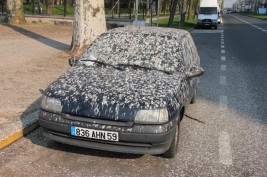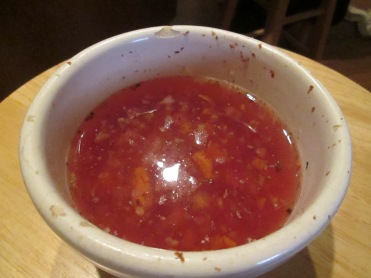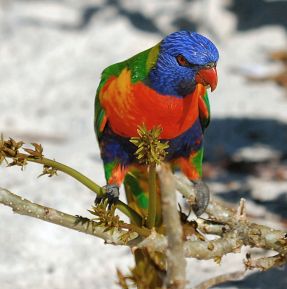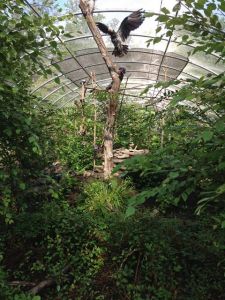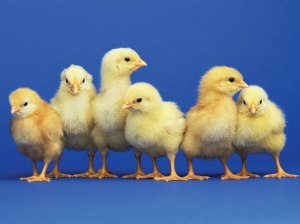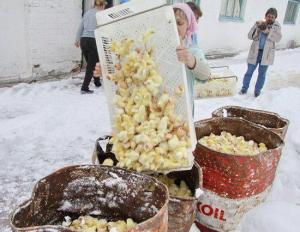
“Hey, wanna hear the most annoying sound in the world?”
~Lloyd Christmas – from “Dumb and Dumber” ~
What do these things have in common:
- Chainsaw
- Lawn mower
- Thunder clap
- A Def Leppard concert
Give up? They’re all quieter than a cockatoo!
Each of the above peak at about 120 decibels. A Moluccan Cockatoo, however, can pierce your eardrums with sounds averaging that, according to the San Diego Zoo. And anyone  having spent time with them, knows full well what the scream of an attention craved cockatoo sounds like!
having spent time with them, knows full well what the scream of an attention craved cockatoo sounds like!
So, much in the same spirit of my blog entry with a similar theme, I bring you the top 6 “Sounds of Not-Silence”.
6. Amazons. Nope, it doesn’t matter which one you chose, just pick a bird at random and you’ll have yourself a “screaming bloody murder, hide the kids, hit the deck” kind of noise-maker in your house. Bring them to your next New Year’s Eve celebration for some real fun… and please remember to fight the urge to leave them there afterwards!
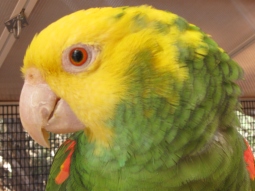
Happy New Aaawwwwk Aaaawwwk Aaaawwk Year!
5. Conures. Who said good things don’t come in little packa…. Oh right… I mean, horrendous eardrum-piercing trills, echoing through your house. Never plan on having another peaceful phone conversation in your life. Ever. Again.
4. Caiques. What is it about these little spazoids that keep earning them a place on these lists? From microwave ovens, to trucks backing up, they seem to take the most simple, common sounds they hear and amplify them ten-fold to unleash Dante’s 9th circle of Hell on your eardrums! Even compared to some of the overtly louder birds on this list, the shrillness of these little birds can cause physical angst among anyone left in the room with them long enough!!
3. African Greys. You thought I’d place these lower, didn’t you? They might seem all sweet and innocent, with their stunning looks and intellectual charm, but that’s all just a guise to throw you off guard. When they want to train you (Ha! You thought you can actually train them?!) they just look at you from across a house and find the one single noise they just know, will piss you off and then repeat it for eternity… or until you get them what they want.
I’ve replaced a smoke detector batteries in my house 7 times in a year and replaced the entire damn thing before I realized my African Grey was secretly enjoying the gag.
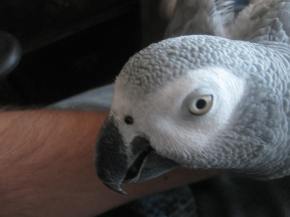
I didn’t do anything… honest!
2. Macaws. These birds are simply a battle of wills. You can give them their toy, play with them, give them a treat or just break down and start screaming at them yourself. Nothing works. They will just pick up their toy, throw it at you, try to take a portion of your finger off when they eat their treat while continuing to yelling at you the entire time. The end of this often results in you trying to out-do your bird; and that’s one battle, you will never be able to win!
1. Cockatoos, specifically Moluccan Cockatoos. The other species can have their moments, and believe me, several Umbrellas have left my ears ringing at times, but Moluccans have to be one of the loudest birds on Earth. Whomever thought a Moluccan Cockatoo would make a great “pet” ought to be locked in a small room with one until their ears bleed – which should only take a few minutes if the bird really craves attention!
I was feeling sympathetic to a Moluccan who really enjoyed my company one time. I brought him home from work to foster him for a while and get him more socialized. The second he open his beak, my dogs evacuated the house and wouldn’t step foot back through the door until he had left the next day. My other birds just looked at me, as if saying “Um…. yeah… he wins!”
So, no, birds are not quiet. You cannot (humanely) de-voice them. Your neighbors will know you have them, as will your neighbor’s neighbor’s neighbor. Size has no effect on the spine-shivering shrillness of some of them. And each bird is guaranteed to find that one wrong time in the wrong place to start making a scene.
The noises they’re capable of unleashing on a human eardrum will make you feel like anything but the emperor basking in the beauty of the nightingale’s song!
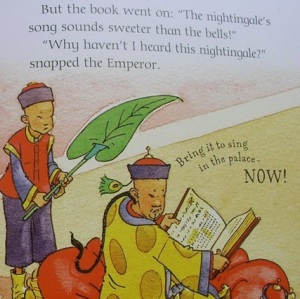
Yes, I meant this story! Check it out in Usborne’s Illustrated Fairytales available over at redrockreading.com
